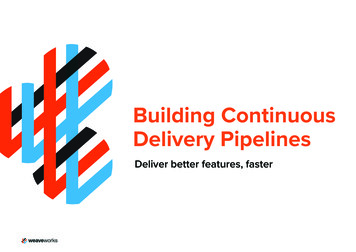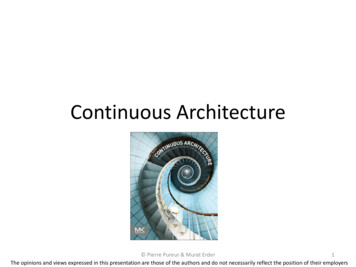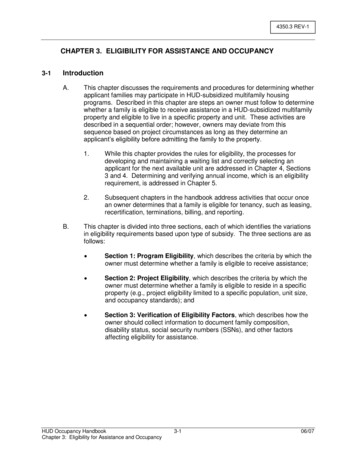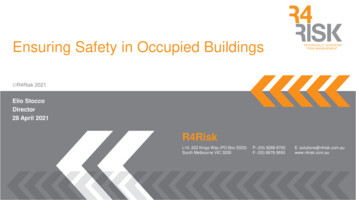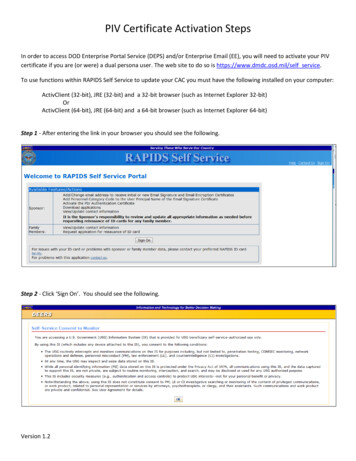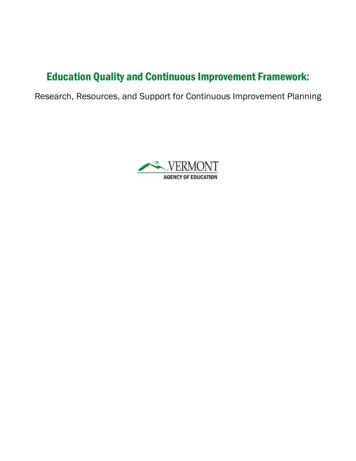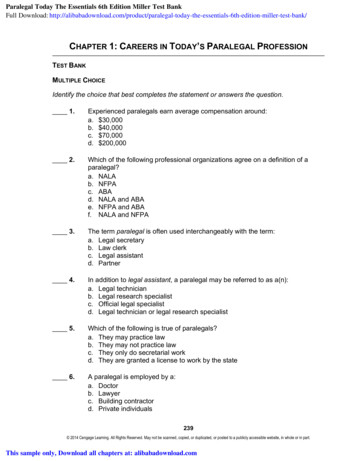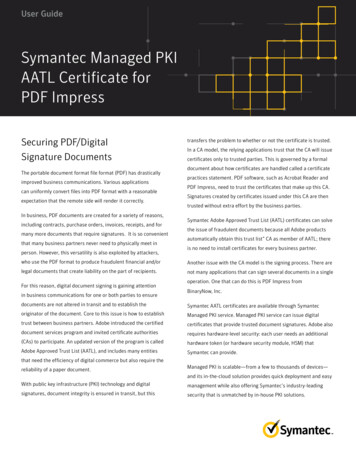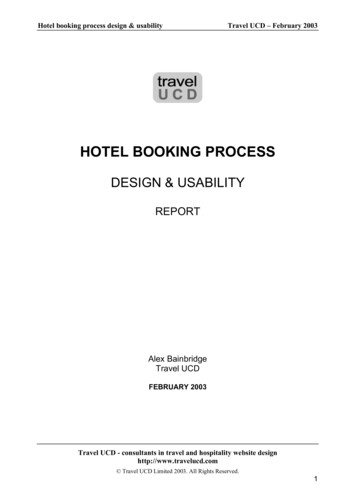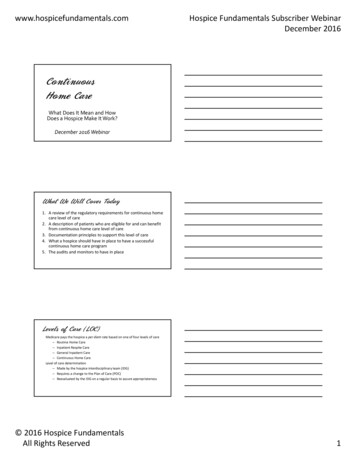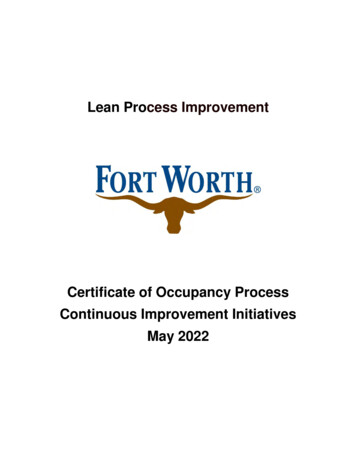
Transcription
Lean Process ImprovementCertificate of Occupancy ProcessContinuous Improvement InitiativesMay 2022
Development Services Department, Certificate of Occupancy BPI ReportContents1.0PROJECT SUMMARY . 12.0INTRODUCTION . 13.0PROJECT CHARTER. 34.0DEFINE PHASE . 54.15.0The Development and CO Process . 5PERFORMANCE MEASURE PHASE .105.1Reduction of Incomplete Submittals .105.2Reduction of PO Permits Voided due to application type .115.3Reduction of Zoning Holds for Bike Racks .125.4Summary of the Measures of Success .136.0RECOMMENDATIONS: IMPROVEMENT PHASE.156.1Standardization .176.2Training .186.3People .196.4Process .206.5Technology .216.6Accountability .227.0THE CONTROL PHASE .238.0CONCLUSION.24APPENDIX A: VOC & VOB MEETING MINUTES, VOC & VOB CONCERNS,PRESENTATIONS, AND EXHIBITSAPPENDIX B: KAIZEN EVENT MINUTES AND PHOTOSMay 2022i
Development Services Department, Certificate of Occupancy BPI Report1.0 PROJECT SUMMARYThis Lean Six Sigma process improvement analysis and implementation plan builds on existingefforts to improve the development process within the City of Fort Worth. It represents a majorstep forward by bringing together all alliance partners associated with the building permitprocess to a culture of continuous process improvement with a standardized, disciplinedapproach. Lean process improvement meetings and events occurred at a measured, organicpace by personnel at many levels and focus group support where needed to reduce lead times,redundancy, and variation; eliminate bottlenecks; improve communication, and expediteprocessing activities related to the issuance of Certificates of Occupancy in the City of Fort Worth.Furthermore, the process improvement exercise promotes a climate of transparency andaccountability.2.0 INTRODUCTIONThe City of Fort Worth has chosen to think strategically about how to improve processes ratherthan remaining with the status quo practice. To effectively improve organizational processes andleverage technology, City management would like to take a critical and in-depth look at a varietyof processes and design improved methods of services delivery in order to further improveefficiencies.The scope of this project included a comprehensive review and analysis of the Certificate ofOccupancy (CO) process, as well as, related support functions associated therewith. Theobjectives of this project were to identify waste, increase departmental cooperation, evaluateand decrease process time, and increase corporate accountability of processes. This report isa culmination of that study which included City of Fort Worth Development Service staff alongwith various members of the development community “Project Team”. The goal was to completethe project by making substantive recommendations based on Voice of Customer (VOC), Voice ofBusiness (VOB), Root Cause Analysis (RCA), and Cumulative Analytics (CA).This project identified problems and possible solutions using the DMAIC method of Lean SixSigma. DMAIC is an acronym for “Define, Measure, Analyze, Improve, and Control” and refersto a systematic five-step approach to process improvement initiatives. This approach served asa data-driven qualitative strategy for this project. As such, this report is divided into sections basedon the DMAIC approach. The process began in March 2021 and meetings were typically held ona monthly basis. Generally, team members identified the current process, reviewed options forimprovement, and proposed potential solutions. The Project Team reached a consensus on theimprovements identified, which are addressed throughout this document.Although this report focuses mainly on the application of permits until the issuance of the Certificateof Occupancy (CO), even those aspects can potentially serve as models for improvement within alldivisions, ultimately to better integrate all functions within the interdepartmental team. This reportwas not intended to identify all process improvement opportunities or to set out a finite planof limited duration. Instead, this report lays a foundation for ongoing and continuous improvementinitiatives for the development review process in the department. In sum, this report is the start ofthe City’s improvement of the Certificate of Occupancy process, not the end of it.May 20221
Development Services Department, Certificate of Occupancy BPI ReportThe Project Team included:Table 1.0: Project Team MembersCity of Fort Worth Staff - Development Services DepartmentJennifer Roberts (Project Lead)Jackson JonesAllison Gray (Process Owner)Juan SalasD. J. HarrellLeo ManteyAsh IbrahimLynn GoforthApril KarrMiranda Meza SanchezArty Wheaton-RodriguezRebecca HernandezCarl SpanglerRichard GarciaDarron BuchananRochell ThompsonEmilio SanchezRochelle JosephEvan RobertsStephen MurrayInkah ReviereTammy LewisKevin YarbroughTy ThompsonDevelopment Partners Focus GroupBill TinsleyEllis& Tinsley, IncBowie HollandEmpire Texas EquitiesBrandon Paul JohnsonKaizen Event FacilitatorCarl BrownSvn Trinity AdvisorsCarl HarkinsConstruction & Fire Prevention Board of AppealsCaroline ClaureCHC DevelopmentCB TeamEllis & Tinsley, IncDrew MartinDM2, LLCElizabeth MearsMission Street Design BuildKari SeherMelt Ice CreamsJonathan KillebrewMetro Code AnalysisMaribel GallardoGreater Fort Worth Association of RealtorsMark PresswoodPanther Real Estate SolutionsNetty MatthewsFort Worth Chamber of CommerceRobert GleesonGreater Fort Worth Association of RealtorsStephen MearsMission Street Design BuildTravis CleggDevelopment Advisory Committee, ChairmanMay 20222
Development Services Department, Certificate of Occupancy BPI Report3.0 PROJECT CHARTERThe Project Team met and developed a Project Charter. Several items of the charter werediscussed and vetted to begin the Business Process Improvement (BPI) exercise; the items arethe Problem Statement, Scope of Problem, and SMART statement. To provide clarity and guidanceto these items, they were defined:Problem Statement: The City of Fort Worth has received customer concerns/complaintsregarding the Certificate of Occupancy process from application to issuance.Scope of Problem: Several areas of concern have been identified as contributing factors to overallprocess complaints, the concerns are as categorized into the following: Communication gap between city and customers Inconsistency in the development process. Time sensitivity, time to review Policy/Ordinance – not user friendly Procedure/Approach – the process is generalized and not ideal for all scenarios Technology – Accela and City website pose some challenges Transparency – The development process is not transparentSMART Statement: Reduce staff related permit expirations and voids by 50% and reduce zoningholds by 25% through staff and customer training by the end of April 2023. Specific – Review and identify, and graphically document the CO processes fromapplication to issuance. Identify process gaps contributing to (internal/external) customercomplaints (E.g. time between plans submittal, and when plans are claimed by plansexaminers), and provide viable solutions using lean methodologies and processimprovement tools. Measurable – Track the number of PO permits that are voided in the system as well asidentify the reason for the expirations and voids. By quantifying the number of expirationsand voids, the communications office can tailor customer and staff training to includecommon errors and omissions that lead to permit voids. Achievable – Yes. Teams (internal/external customers) have been formed, and possessthe tacit knowledge and skills to conduct the commercial building permit processimprovement. Relevant – The commercial building permit process improvement from application toissuance is in concert with executive management’s vision of continuous qualityimprovement. Time-bound – Improve the CO process by end of December 2022.During the BPI exercise, the Scope of Problem was expanded and delved into further to uncoverroot causes, and better understand the causalities and effects caused by the inefficiencies andconcerns of the current state of the permitting processes.The BPI process encountered several challenges that were addressed as the exercise progressed;one challenge was the scheduling of meetings with the various team members. Creating an internalMay 20223
Development Services Department, Certificate of Occupancy BPI Reportand external team with dynamic work schedules was challenging, yet accomplished during theBPI. However, the scheduling challenge affected the overall exercise length, resulting in extendingthe exercise timeframe.May 20224
Development Services Department, Certificate of Occupancy BPI Report4.0 DEFINE PHASEDefinition and Terminology:Application Submittal Date – The date a building permit application has been deemed to haveall plan set components and is accepted by the City of Fort WorthApproval date – The date all required departments have reviewed and approved a customer’ssubmitted building plan sets and all associated fees have been paidBPI – Business Process ImprovementCoU – Occupancy Change of Use PermitDMAIC – Define Measure Analyze Improve ControlIncomplete Submittals - Applications that do not have all the required documents for reviewOpen Date – The date a building permit is initially applied for, and its information is entered intoAccela by the applicant or customer service representativeRouting – The process of officially sending the building permit application and plan-sets to City ofFort Worth staff reviewing the permit for approvalIssue Date – The date all building permit requirements have been met, and the customer receivestheir approved building permit and inspection cardsFinalized – The date building construction is complete, and has passed final City inspectionSMART – Specific Measurable Attainable Relevant Time-boundVOB – Voice of BusinessVOC – Voice of CustomerVoided Permits - permits that are removed or cancelled by the applicant or customer afterapplication4.1 The Development and CO ProcessThe Project Team’s goal was to better understand the current overall process and steps requiredfrom the customer initiation of the process to the issuance of permits so that the City can helpcustomers choose the right permit type and submit the right information for that permit.The team held several meetings with City staff (VOB) and development stakeholders (VOC)involved in this process. From those meetings, an existing process flow diagram was developedto clearly define and understand the steps required, for submittals, to obtain a Certificate ofOccupancy. Meeting minutes, presentations, lists of VOC and VOB Concerns, meeting exercises,and process maps can all be found in Appendix A. Two Kaizen events were also held with theVOC and VOB led by a Lean Six Sigma Master Black Belt to brainstorm recommendations andimplementation opportunities. Meeting minutes and photos from the Kaizen events can be foundin Appendix B.As with any process, there are peripheral and/or sub-processes that may occur simultaneously orduring the different phases of a process that is undergoing improvement. These challenges, mustbe addressed throughout the BPI exercise. The Project Team conducting the BPI exercise may ormay not have influence over or cooperation from other departments within the organization, addingadditional challenges in achieving the future state. However, with executive management support,leadership, resources, and motivated team members this BPI exercise will achieve success.May 20225
Development Services Department, Certificate of Occupancy BPI ReportFigure 4.1: CO Customer Decision Tree Page 1May 20226
Development Services Department, Certificate of Occupancy BPI ReportFigure 4.2: CO Customer Decision Tree Page 2May 20227
Development Services Department, Certificate of Occupancy BPI ReportFigure 4.3: CO Process SimplifiedMay 20228
Development Services Department, Certificate of Occupancy BPI ReportFigure 4.4: In House Review FlowchartMay 20229
Development Services Department, Certificate of Occupancy BPI Report5.0 PERFORMANCE MEASURE PHASEA team comprised of City of Fort Worth development staff and external developmentstakeholders analyzed process performance. There were two Kaizen events organized tothoroughly discuss the situation at hand and recommend ways mitigate identified challenges.Performance measures track and follow the progress of the departmental activities, collect relevantinformation and helps stakeholders to study trends to make informed decisions. It brings efficiencyand efficacy to the processes and thereby creates positive results for the organization.The project team identified three areas to measure success. It is expected that these identifiedparameters will be a measure to assess the department’s progress on issuing Certificate ofOccupancies. The identified measurement parameters are: Reduction of incomplete submittals for PO permits related to CO requestsReduction of PO permits voided related to incorrect application type for CO requestsReduction of Zoning Holds for Bike Racks related to CO requests5.1 Reduction of Incomplete SubmittalsThis involves measuring the number of applications that were flagged as Incomplete Submittalsduring the CO application process. The source of the data was derived from the department’spermitting software, Accela Application system. The data review period was for the Fiscal Year2021 (October 2020 to September 2021). The measurement took into consideration the totalincomplete submittals per month throughout the fiscal year versus the total PO submittalsTable 5.1 Table showing Incomplete Submittals for Fiscal Year 3,971# of POIncompleteSubmittal281417122127362637485460380% Incomplete/ Total PO8%4%5%3%8%10%10%8%15%13%14%17%10%TypeTotal POTotalFigure 5.1 Chart showing Incomplete Submittals for Fiscal Year 23232323232323232May 202210
Development Services Department, Certificate of Occupancy BPI ReportThe measurement above took into consideration 3971 permits in the Fiscal Year 2021.Out of thesubmitted PO number, 380 (10%) of the applications were flagged as incomplete submittals in theinitial stages. Incomplete submittals are those applications missing some or all of the requireddocumentations to be routed for first review. Hence, those applications were sent back to thecustomers for them to resubmit. A review of the permitting system to not allow permit submittalswithout all of the required documents would decrease applications missing the appropriatedocuments. This modification will require coordination with Strategic Operations and theDevelopment Support for implementation. The goal of the department is to see a 50% reductionin the average number of Incomplete Submittals from 10% to 5% by the end of fiscal year 2022.Once the application process is amended, there should no longer be the ability to submit anincomplete application. Additionally, the Communication Specialist will need to put together aninformation packet to notify customers of the permit changes and the documents required to beincluded with the submittal. Decreases in incomplete submittals will show the Department hasimproved communications with the customers and staff to ensure the specific documents areprovided for the permit and customers are able to utilize the Accela permitting software properly.5.2 Reduction of PO Permits Voided due to application typeThis involves measuring the number of applications that were flagged as Voided during the COapplication process. The source of the data was derived from the department’s permitting software,Accela Application system. The data review period was for the Fiscal Year 2021 (October 2020 toSeptember 2021). The measurement took into consideration the total permits voided per monththroughout the fiscal year.Table 5.2 Table Showing PO Permits that were Voided in Plan Review for Fiscal Year n21Jul21Aug21Sep21TotalTotal PO3623153263592692823513392553603923613,971# of 12%11%12%16%10%9%5%6%11%% of Voided/14%Total POFigure 5.2 Chart Showing PO Permits that were Voided in Plan Review for Fiscal Year 73737373737373737May 202211
Development Services Department, Certificate of Occupancy BPI ReportThe measurement above took into consideration 3971 permits in the Fiscal Year 2021, out of thesubmitted PO number, 445 (11%) of the permits were voided in the permitting process. Permitsthat are voided are those permits that are removed or cancelled by the applicant or customer afterapplication. Customers/applicants sometimes decide to void or cancel their applications. A reviewof the voided permit is necessary to determine if the voided permits are due to customers notapplying for the right permit type vs. Customers that decide not to proceed with the permit for otherreasons.The goal of the department is to see a 50% reduction in the average number of Voided applicationsfrom 11% to 5.5% by the end of fiscal year 2022. A reduction in voided applications will be anindication that the City provides all the necessary information to our customers to help them makeinformed decisions before applying for permits.5.3 Reduction of Zoning Holds for Bike RacksThis involves measuring the number of applications that were flagged as having zoning holdsduring the application process. Some permits go through zoning requirements before they moveto the next step in the permitting process. The source of the data was derived from thedepartment’s permitting software, Accela Application system. The data review period was for theFiscal Year 2021 (October 2020 to September 2021). The measurement took into considerationthe total zoning holds per month throughout the fiscal year.Table 5.3 Table Showing PO Permits that had zoning holds in Fiscal Year n21Jul21Aug21Sep21TotalTotal PO3623153263592692823513392553603923613,971# of PO onHolds Permits282715301224214219343531318% of Holds / Total8%PO9%5%8%4%9%6%12%7%9%9%9%8%Figure 5.3 Chart Showing PO Permits that had zoning holds for Fiscal Year 3131313131313131313131May 202212
Development Services Department, Certificate of Occupancy BPI ReportThe measurement above took into consideration 3971 permits in the Fiscal Year 2021, Out of thesubmitted PO number, 318 (8%) of the permits had zoning holds. Zoning holds refer to the permitapplications that are held as a result of not meeting all the zoning requirements before they can beissued. From discussions with VOC and VOB, most of the zoning holds are as a result of notmeeting the bike rack requirement. Further evaluation of the CO permits that were held for zoningis necessary to determine what percentage of the zoning holds are due to the bike rackrequirement. A further analysis of the zoning requirements related to the CO permits should bepursued to ensure that there are consistent reviews within the zoning section. Furthermore, anevaluation of the zoning requirements related to the CO should be done.A customer education program regarding the zoning requirements related to Change of Usepermits is critical to the reduction of permits being held for zoning requirements. As a componentof the customer outreach to improve consistency, inclusion of the zoning requirements, will benecessary.The goal of the department is to see a 25% reduction in the average number of zoning applicationholds from 8% to 6% by the end of fiscal year 2022. During the Kaizen events, one of therecommendations was for the city to review the bike rack requirements. Currently, a Change ofUse application for a tenant space over 1000 square feet requires a bike rack. VOC believes thisis a challenge to the zoning review process and recommends staff take a critical look at it again tomake it more development friendly.5.4 Summary of the Measures of SuccessThe table and chart below summarize the three measures of success and compares the numbersfor the fiscal year. From the data below, Voided Permits occurred most frequently. This could bedue to a variety of reasons; however, once modifications and education are implemented, thenumber of voids should decrease. Staff will investigate all four measures and find effective waysto reduce these measures.May 202213
Development Services Department, Certificate of Occupancy BPI ReportTable 5.4 Table Showing all Measures of Success for Fiscal Year 2021FY' 2021Total POApplicationsIncompleteSubmittalsVoidedZoning tal3971326445318Table 5.5 Table Showing Monthly Average Measures of Success for Fiscal Year imum1212012ExpiredVoidedZoning Holds153727Figure 5.4 Chart Showing all Monthly Average Data for Measures of Success for Fiscal Year 2021403530252015105032Incomplete SubmittalMay 202215Expired37Voided27Zoning Holds14
Development Services Department, Certificate of Occupancy BPI Report6.0 RECOMMENDATIONS: IMPROVEMENT PHASEThe recommendations and solutions listed were derived from a brainstorming exercise conductedduring the two Kaizen events. Recommendations and solutions for process improvements weredeveloped to address concerns from City staff and the development community.The Project Team went through an initial evaluation of ideas and a “PICK Chart” was created toprioritize a number of action items or problem-solving ideas. PICK is an acronym for Possible –Implement – Challenge - Kill. This chart was utilized for a visual comparison of action items relativeto their impact to the problem being addressed as well as the ease and cost of implementation.May 202215
Development Services Department, Certificate of Occupancy BPI ReportFigure 6.0: PICK ChartLOWPayoffHIGHPayoffImplementChallenge Identify and train additional DSD websiteliaisons to update City website and work onpublic outreach programs All DSD website liaisons review theDepartment’s webpages, identify broken links,and work to restore them. Website Updates:o Define “Certificate of Occupancy” forcitizens to fully understand what it is for oroutline what triggers it.o Explain what triggers an OccupancyChange of Use permit to eliminateconfusion and redundancy.o Describe what is needed for a permitapplication.o Upload Floor Plan and Site Plan exampleso Upload the updated Use Verification Formo City/Departmental webpage should besimplified for easy information search.o Add a Decision Tree/flowchart for customero Create a Dedicated webpage to giveinformation on the review process Use other record types to establish use inaddition to previous Certificate of Occupancy Use ACA (Accela Customer Access to givemore information to the public) Require the Zoning check vis CFW PermitAssist BEFORE submitting a Change of Useapplication The development process/ Accela tutorialvideos on the website needs to be cleanedup to suit current needs of customers. Simplify the CO process for projects ofsmaller sizes. DSD needs a communications andcustomer education team for web updatesand customer education programming. Create New Permits Types in Accela bybreaking up of existing permit types tocater for all diverse permit types. Create a Separate record in Accela for CO Automate the CO issuance process and tieit to Final Building permit in Accela Zoning Team to evaluate the bike rackrequirement for Change of Use permits.Then amend the Zoning Ordinance torevise the bike rack requirements forchange of use permits, accordingly.o Currently, a Change of Use applicationover 1000 sq. ft. requires a bike rack Scan and index all old permits/documentson microfilm and save it on a shared drivefor internal use and easy access to publicwhen requested. Move all CO's into Accela and make themsearchable Scan, catalogue, map, put in Accela innew CO record type Promote Educational/ PR campaign on the Link CFW Permit Assist to Accela todevelopment review process.transfer information entered data which willo Use mediums such as Facebook, Twitter,help save time and reduce redundancy.Instagram Program CFW Permit Assist to do more for Add question to Customer Service Survey onthe CO process.the Application to Issuance process to collect Link GIS to Accela and integrate parcelcustomer views on the process and to help citydatastaff measure their success (Example: How doyou like our new process?) Separate and rename permits so they are moredescriptivePossibleEASYTo implementMay 2022KillHARDTo implement16
Development Services Department, Certificate of Occupancy BPI Report6.1 StandardizationAfter analyzing the available data and causal relationships described in the preceding sections, theGroup recommendations included an improved and increased level of process standardization.The list of standardization recommendations are as follows:Timeframe#1ActionCreate a more thorough and up-to-dateapplication checklist for customers. Thechecklist must include the documentsnecessary for CO application submittal,zoning requirements, and necessaryplan set requirements. The updatedcommercial checklists shall have inputfrom City staff and pr302023Ongoingo The checklist should be drafted tohave a separate system for Remodelsand Non-Remodels application.2Create a simpler CO process forprojects of smaller sizes.PlanReview/DSSALLX3Separate and rename permits so theyare more descriptiveStrategicOps TechPlanReviewX4Clearly define “Certificate of Occupancy”for citizens to fully understand what it isfor or outline what triggers it.PlanReview/DSSALLMay 2022X17
Development Services Department, Certificate of Occupancy BPI Report6.2 TrainingAfter analyzing the available data and causal relationships described in the preceding sections, theProject Team recommends consistent periodic targeted training for external/internal customers.Specific training recommendations are as follows:Timeframe#ActionLeadPartner(s) Sept3020221Train DSD website liaisons to checkwebpages, identify broken links, andwork to restore themStrategicOps TechALL2The department needs acommunications and customereducation team for web updates andcustomer education programming.ExecutiveTeamALL3Provide more training on Accela CitizenAccess; customers still have challengeswith utilizing the full capabilities of thepermitting software.StrategicOps TechALLMay 2022Apr302023XOngoingXXXX18
Development Services Department, Certificate of Occupancy BPI Report6.3 PeopleA key component to customer service is managing customer expectations. Issues such as staffattitudes, staffing levels, management and coordination, also contribute to process delays.The project team recommends improved personnel time management, interdepartmental taskcoordination, and management of customer expectations. Specificimprovementrecommendations are:Timeframe#ActionLeadPartner(s)1Hire more staff members if needed tomake the process faster. Providestaffing analysis to justify workload vsnumber of staff needed.ExecutiveTeamStrategicOpsTech2Provide bi-annual update on themeasurements of success (incompletesubmittals, voided permits and zoningholds).StrategicOps TechDSS3Coordinate with Alliance partners andprovide periodic updates on progressALL4Identify and train additional DSDwebsite liaisons to update City websiteand work on public outreach programsStrategicOps TechMay 2022Sept302022Apr302023OngoingXXXALLXX19
Development Services Department, Certificate of Occupancy BPI Report6.4 ProcessBased on feedback from the meetings, it was concluded that the CO application process currentstate lacks standardization in certain areas and “checks and balances” in others. Furt
1.0 PROJECT SUMMARY This Lean Six Sigma process improvement analysis and implementation plan builds on existing . the process improvement exercise promotes a climate of transparency and . this report lays a foundation for ongoing and continuous improvement initiatives for the development review process in the department. In sum, this report .
